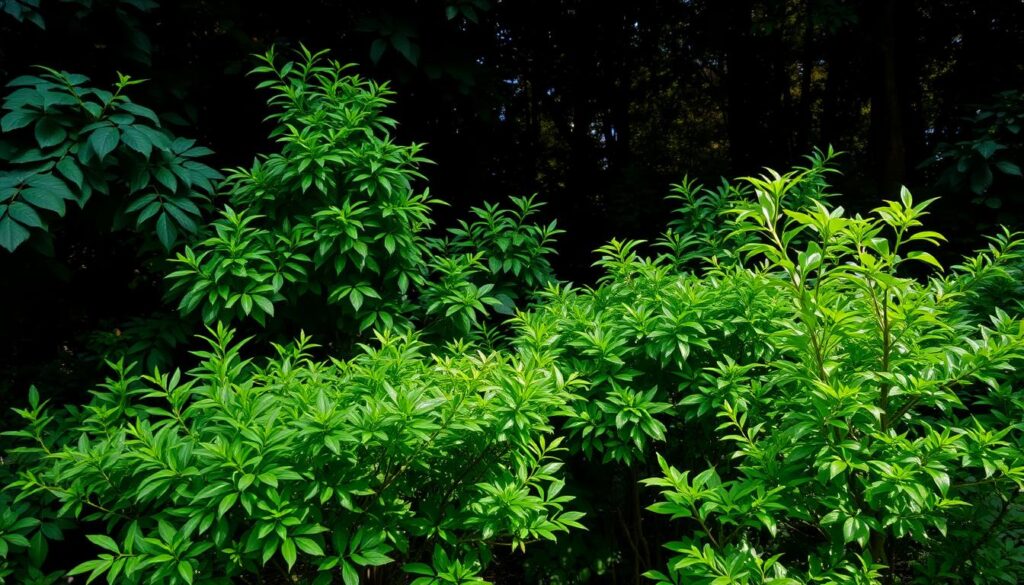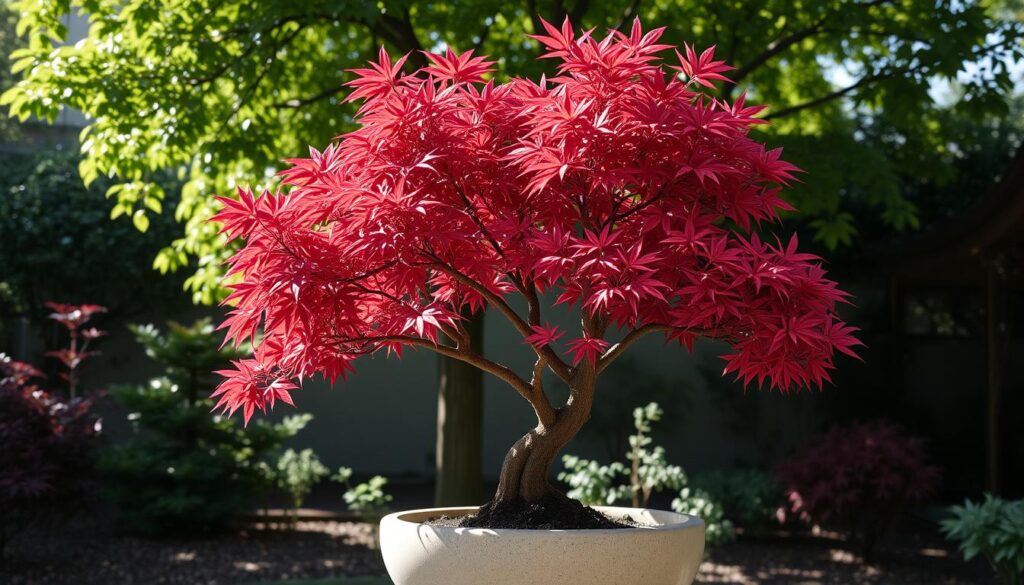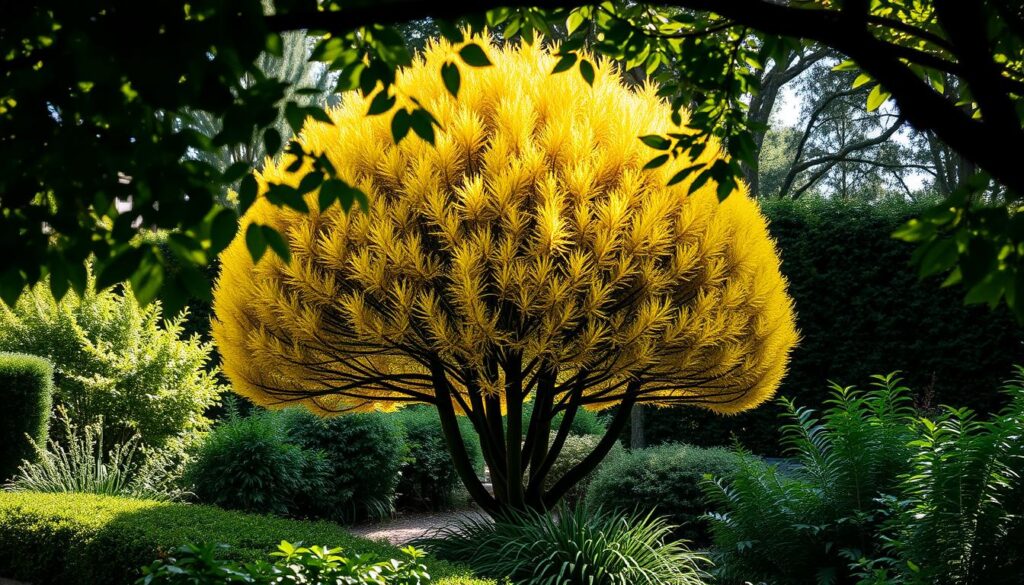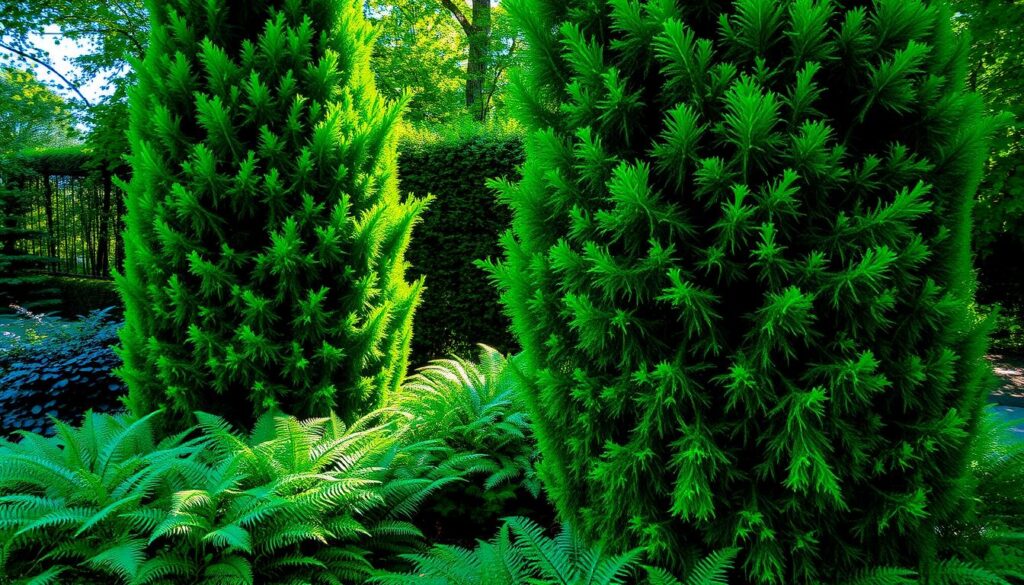Do you find it hard to pick plants for dark, dimly lit garden corners? There are many small, shade-loving low light trees that can make these spots lively all year. But which ones are perfect for shady gardens?
In this guide, we’ll look at the best low light trees for little sunlight. They add color, interest, and structure to your garden all year. You’ll find everything from dwarf Japanese maples to tough conifers to brighten up your garden’s shady spots.
Key Takeaways
- Discover a variety of low light tree species suitable for shady garden spaces
- Learn about the specific light, watering, and temperature requirements for each tree type
- Explore compact, dwarf, and narrow-growing options for limited spaces
- Uncover practical solutions to address common issues with indoor trees
- Understand the benefits of using grow lights to supplement low light conditions
Introduction to Shade-Tolerant Trees
The Importance of Trees and Challenges of Shady Landscapes
Trees are vital in our gardens and communities. They produce oxygen, filter air, reduce noise, and provide shade. But, growing trees in shady spots can be tough. This section will look at the role of trees and the hurdles of planting them in dark areas.
The importance of trees is huge. They keep our ecosystems healthy, improve air quality, and make our outdoor spaces look better. But, not all areas get lots of sunlight. This makes picking the right tree for shady spots hard.
| Shade Tolerance Measure | Performance in Distinguishing Shade Tolerance |
|---|---|
| Low-light abundance index | Most objective and practical |
| Demographic rates (growth and mortality) | Good indicators of plant performance in response to environment |
| Relative growth rate (RGR) in low-light | Shade-tolerant species assumed to have larger RGR |
| Canopy openness and light environment | Commonly used to assess shade tolerance |
| Organ- or sub-organ-level plant traits | Indicative of shade tolerance in tree species |
Shade-tolerant trees grow well in dark places. They use far-red light better for photosynthesis. They also have wider, thinner leaves to catch more sunlight. Knowing about these trees is key to making shaded areas lively and green.
Short and Compact Trees for Shady Spots
For tight, shaded garden spots, choose short and compact trees that do well in shade. The weeping willow-leaved pear and the ‘Golden Glory’ cornelian cherry are great picks.
Weeping Willow-Leaved Pear: A Sparkling Understory Option
The weeping willow-leaved pear grows up to 20 feet tall and wide. Its silver-green leaves hang down, creating a beautiful shimmer. It’s perfect for shady areas and grows well in zones 4 to 7.
‘Golden Glory’ Cornelian Cherry: Early Spring Blooms and Fall Berries
The ‘Golden Glory’ cornelian cherry is another great choice for shady spots. It grows 10 to 15 feet tall and wide. It blooms with bright yellow flowers in spring and has red berries in fall. It thrives in zones 5 to 8, adding beauty all year.

| Tree Species | Height x Width | USDA Hardiness Zones |
|---|---|---|
| Weeping Willow-Leaved Pear | 20 ft x 20 ft | 4-7 |
| ‘Golden Glory’ Cornelian Cherry | 10-15 ft x 10-15 ft | 5-8 |
“For cramped, shady areas, short and plump trees are ideal. The weeping willow-leaved pear offers a delicate, silvery sheen and pendulous habit, while the ‘Golden Glory’ cornelian cherry boasts early spring flowers and fall berries – making them both excellent understory options.”
low light trees for Limited Spaces
In small, shaded gardens, compact evergreen trees like the mountain hemlock offer structure all year. They give a woodsy feel. The mountain hemlock has soft, feathery foliage and slightly drooping branches.
It’s perfect as an understory plant. It connects ornamental beds to taller forest trees.
Mountain Hemlock: A Feathery Evergreen for Shady Gardens
The mountain hemlock (Tsuga mertensiana) grows slowly and is an evergreen. It loves partial shade and cool, moist places. Its feathery needles and pyramidal shape are great for small, low light trees in tight space trees.
This hardy conifer can handle many soil types. It’s also good at surviving without much water once it’s settled. This makes it a strong choice for mountain hemlock gardens.
“Mountain hemlock is a great option for creating a cozy, woodland feel in small shady areas. Its soft, lush foliage and compact size make it perfect for tight spaces that don’t get a lot of direct sunlight.”
When picking a mountain hemlock, look for ‘Brounii’ or ‘Lantangil’. They grow to 10-15 feet tall and wide. This is ideal for smaller yards and gardens. With the right spot and care, this evergreen will add interest all year. It will also bring a lush, natural look to your shaded outdoor areas.
Dwarf Japanese Maples for Container Planting
Japanese maples are loved for their bright colors. But, their big size can be a problem for many gardens. Luckily, the ‘Red Wood’ Japanese maple is a solution. It’s a dwarf variety that’s 12 feet tall, perfect for containers or small spaces.
‘Red Wood’ Japanese Maple: Year-Round Interest in a Small Package
The ‘Red Wood’ Japanese maple is a real showstopper. It has deep burgundy-red leaves that turn scarlet in fall. Its slender branches and small size make it great for containers or small gardens. Japanese maples love partial shade, making the ‘Red Wood’ a versatile choice for shady spots.
Dwarf Japanese maples like the ‘Red Wood’ are perfect for container gardening. They grow to be 6-10 feet tall, fitting well in pots. With proper care, they become a stunning centerpiece, offering color and texture all year.
- Compact, 12-foot mature size
- Vibrant red foliage that turns scarlet in fall
- Thrives in partial shade, making it ideal for container planting
- Slow-growing habit perfect for long-term container cultivation

When picking a container for your ‘Red Wood’ Japanese maple, choose a sturdy one. Use stone, ceramic, or terracotta pots. These materials help keep the tree stable, even in windy conditions. Fertilize lightly and water deeply twice a week. Increase watering during dry spells. With proper care, your dwarf Japanese maple will thrive, adding beauty to your outdoor space.
Compact River Birch Varieties for Small Gardens
River birches can make a big impact on a landscape. But, their tall size might be too much for small gardens. Luckily, the ‘Fox Valley’ river birch, also known as ‘Little King’, is a great option. This river birch has the same beautiful bark but is only 10-15 feet tall. It’s perfect for shady spots.
‘Fox Valley’ River Birch: Exfoliating Bark and Shade Tolerance
The ‘Fox Valley’ river birch is a hardy, compact tree that grows well in USDA Hardiness Zones 4-10. It’s known for its moderate growth and can be used as a hedge or privacy screen. Its green leaves and love for shade make it a great choice for shady areas.
| Characteristic | Description |
|---|---|
| Growth Zones | 4-10 |
| Growth Rate | Moderate |
| Landscape Use | Hedge, Privacy Screen |
| Foliage Color | Green |
The ‘Fox Valley’ river birch is a top pick for small gardens and shady spots. Its unique bark and love for shade make it a valuable addition to any landscape.
Tall and Slender Trees for Narrow Spaces
In tight spots like side yards or against foundations, tall narrow trees add height and structure. They don’t take up too much space. These slim trees are perfect for making vertical focal points in shady gardens.
The Forever Goldie Golden Arborvitae grows 15 to 20 feet tall and only 3 feet wide. The Wissel’s Saguaro False Cypress reaches 8 to 10 feet tall and stays 3 feet wide.
The Little Gem Magnolia can grow up to 20 feet tall and 7 to 10 feet wide. The Blue Surprise Port Orford Cedar is also narrow, reaching 8 feet tall and 2 to 3 feet wide.
When picking tall narrow trees for your garden, remember. Most small trees under 20 feet like filtered light or dappled shade. This helps them grow well and stay healthy.

Flagpole Cherry: A Spectacular Bloom Display
Gardeners looking for spring beauty in shady spots should think about the flagpole cherry. This columnar cherry tree is a stunning sight. It’s perfect for tight spaces, making it great for small or city gardens.
In early spring, it bursts into life with delicate, pale pink flowers. These flowers cover its branches, creating a stunning vertical display. After the flowers drop, its green leaves turn into a vibrant red and orange in fall. This tree brings beauty all season long.
The flagpole cherry grows up to 20 feet tall and 10 feet wide. It’s a great choice for those who want a smaller columnar cherry tree but still want the look of spring blooming trees. It thrives in USDA Hardiness Zones 5 to 8. It’s perfect for adding a vertical touch to shady gardens, fitting well in various landscape designs.
| Cultivar | Hardiness Zones | Size (Height x Width) |
|---|---|---|
| Flagpole cherry (Prunus serrulata ‘Ama-no-gawa’) | 5 to 8 | 20 feet tall, 10 feet wide |
“The flagpole cherry’s delicate pink flowers and compact columnar form make it a standout choice for adding vertical interest and spring beauty to shady garden spaces.”
Lion’s Head Maple: Unique Foliage Texture
The lion’s head maple is a standout among compact maples. Its leaves curl up like a lion’s mane. It grows slowly and stays upright, perfect for shady spots or paths.
This maple grows to about 15 feet tall and 10 feet wide. Its leaves twist and curl, adding interest to the garden. It does well in partial shade, making it versatile for many garden spots.

The lion’s head maple is eye-catching and can handle different soils. It does well in sandy, loamy, or clay soils as long as it drains well. It’s great for adding mystery to shaded areas or along paths.
Use the lion’s head maple as a focal point or part of a border. Its size and adaptability make it perfect for adding texture to shaded gardens.
‘Ruby Vase’ Persian Ironwood: A Four-Season Star
The ‘Ruby Vase’ Persian ironwood (Parrotia persica) is perfect for a shady garden. It has a slender shape that adds scale and structure. Its leaves change color from ruby red to orange and purple in fall, and it has beautiful bark and flowers in spring.
This tree loves partial shade and is great for small gardens. It grows up to 28 feet tall and 12-16 feet wide. It’s a stately tree that doesn’t take over the garden.
The fall foliage of this tree is amazing. Leaves turn from ruby red to orange and purple, creating a beautiful show. The bark also changes colors, adding interest all year.
Despite looking delicate, the ‘Ruby Vase’ Persian ironwood is very hardy. It grows well in USDA Hardiness Zones 4-9 and can handle some drought. It does best with good drainage and occasional watering, in sun or shade.
If you want a tree that looks great all year, choose the ‘Ruby Vase’ Persian ironwood. It’s beautiful, easy to care for, and perfect for shady gardens. It’s a great choice for any landscape, offering beauty and interest all seasons.
Golden Irish Yew: An Evergreen Alternative
For gardeners looking to brighten up shady spots, the golden Irish yew is perfect. It has golden leaves that light up dark areas. This makes it a great choice compared to usual green-needled trees.
The golden Irish yew grows in a narrow, fastigiate shape. It’s great for hiding utilities or making narrow evergreen hedges in small spaces. It can grow 30 to 60 feet tall but only 15 to 25 feet wide, fitting well in smaller gardens.

This yew is easy to grow in shade, unlike many others. It does well in partial to full shade. Its ability to thrive in low light and its compact size make it a great choice for smaller gardens.
Looking to create a lush hedge or add color to a shaded bed? The golden Irish yew is a top pick that won’t let you down.
Shade-Loving Evergreen Trees
Homeowners often forget about evergreen trees for shady spots. But, many evergreen species love shade and add greenery all year. The American holly and boxwood are great examples.
American Holly: Spiky Leaves and Bright Berries
The American holly grows slowly and can reach 25 to 60 feet tall. Its leaves are dense and glossy, with sharp spikes. In fall and winter, it shows off bright red berries.
This tree does well in zones 5 through 9. It likes partial shade to full sun.
Boxwood: A Classic Hedge Plant for Partial Shade
Boxwood is a top pick for formal gardens and hedges. It grows 15 to 20 feet tall and has a lush, compact shape. Its deep green leaves are a standout feature.
Boxwood prefers partial shade to full sun. It thrives in zones 5 through 8.
For a bold evergreen centerpiece or a low-care hedge, consider American holly and boxwood. They’re perfect for shady spots. Their beauty and hardiness make them top shade evergreens for your yard.
Coniferous Shade Tolerators
Some coniferous trees can grow well in shaded areas. The Colorado blue spruce and the deodar cedar are great examples. They add beauty to gardens that don’t get much sunlight.
Colorado Blue Spruce: A Festive Focal Point
The Colorado blue spruce keeps its Christmas tree shape in partial shade. Its blue needles stand out, making it a beautiful centerpiece for shaded gardens. This tree has more chlorophyll, helping it use sunlight better.
Deodar Cedar: Graceful Drooping Branches
The deodar cedar has drooping branches that make shaded areas look elegant. It has soft, blue-green leaves and can grow well in tough spots. Unlike some trees, it keeps its natural shape, even in low light.
Not many plants do well in deep shade, especially in dry soil. But the Colorado blue spruce and deodar cedar are exceptions. They provide beauty and structure to shaded parts of the garden all year.

Resilient Junipers for Challenging Conditions
Junipers, like the famous eastern red cedar, are incredibly tough trees. They can grow well in many tough spots, from shady areas to harsh climates. With over 50 to 60 types grown in gardens, these evergreens are known for being very adaptable and resistant to pests.
The eastern red cedar stands out among junipers. It’s loved for its ability to handle heat, cold, and dryness. Growing in USDA zones 2 through 9, it’s a great pick for gardeners in tough environments.
Eastern Red Cedar: Heat, Cold, and Drought Tolerant
The eastern red cedar is a hardy tree that can handle a lot. It can grow in many temperatures and soils. Its deep roots and natural defenses against pests like deer and rabbits make it perfect for low-maintenance shady gardens.
It does well in wet springs, hot summers, and cold winters. This makes it a great choice for areas where other plants might struggle.
Junipers come in many shapes and sizes, each with its own special features. From the tall ‘Skyrocket’ to the low ‘Pancake’, there’s a juniper for every garden. These hardy trees are ideal for creating beautiful, tough gardens, even in the toughest spots.
Arborvitae: Versatile Evergreens for Shade
Arborvitae trees are great for making private gardens in shady spots. They grow well in partial shade. This makes them perfect for adding privacy, structure, and greenery all year.
Emerald Arborvitae: A Lush Privacy Screen
The Emerald Arborvitae shines in shady spots. It’s from the eastern U.S. and can grow up to 15 feet tall and 4 feet wide. Its dense, green foliage is great for privacy and can handle cold in USDA Hardiness Zones 2-8.

Giant Arborvitae: Rapid Growth in the Shade
The Giant Arborvitae is great for those wanting a big shade-tolerant evergreen. Known as the “Green Giant,” it can grow up to 60 feet tall. It grows fast, adding 3-5 feet each year, perfect for shaded privacy.
“Arborvitae (Thuja) offers a wide variety of sizes and colors for different landscape situations.”
Arborvitae trees are versatile for creating privacy screens or shaded garden focal points. They tolerate partial shade and come in various sizes. They’re a top choice for transforming shady outdoor spaces.
Yews: Ornamental Conifers for Shade Gardens
Yews (Taxus spp.) are great for shady spots. They add interest all year with their dense, evergreen leaves. They come in different sizes and shapes, perfect for shaded areas.
Golden Irish Yew: Variegated Needles and Low Canopy
The golden Irish yew stands out in shady gardens. It has variegated needles in gold and green, making it a beautiful sight. Its low, spreading habit is great for areas under tall trees or small spaces.

Yews do well in many soils and light conditions. They like partial shade but some, like the golden Irish yew, can handle full shade. This makes them a great choice for low-light spots. They are both tough and beautiful, adding value to any shade garden.
| Characteristic | Golden Irish Yew |
|---|---|
| Growth Habit | Compact, mounding |
| Foliage Color | Variegated gold and green |
| Light Requirements | Partial to full shade |
| Mature Size | 3-6 feet tall, 4-8 feet wide |
Hemlock: The Ultimate Shade Endurer
The hemlock (Tsuga canadensis) is a standout among shade-tolerant trees. It’s known for its ability to thrive in very shady spots. It can live for centuries in dense, shaded areas.
It loves moist, well-drained soil and partial to full shade. The hemlock adds beauty to any shady garden.
Hemlocks have evolved to use the little light they get in dense forests. Their delicate leaves and compact growth help them survive in deep shade.
- Hemlock (Tsuga canadensis) grows in USDA Hardiness Zones 3-7.
- Mature hemlocks can reach heights of 70 feet tall and widths of 25-35 feet.
- Hemlocks are considered the most shade-tolerant of all tree species, able to thrive in partial to full shade for centuries.
- Their graceful, feathery appearance and long lifespan make hemlocks a valuable addition to shady garden landscapes.
For those looking for a reliable, long-lived tree for shady spots, the hemlock is perfect. It’s not just shade-tolerant but also has an elegant form and stays green all year.

Japanese Yew: Shade-Loving with Bright Berries
The Japanese yew is a top pick for gardens that don’t get much sunlight. It’s an evergreen shrub or small tree that loves shade. It’s perfect for spots that are hard to reach with sunlight.
Its dark green needles add texture, and the bright red berries bring color all year. It can grow up to 50 feet tall. It’s tough and can handle cold temperatures down to -30°F, making it great for zones 4-7.
This plant can live a long time, up to 400 to 600 years in the wild. But, it’s toxic to humans and pets. So, be careful if you have kids or pets around.
The Japanese yew likes well-drained soil and a pH between 5.3 and 7.8. It looks good when pruned, and you can shape it into different forms. You can also use cuttings to make new plants that look like the original.

While it needs some care to avoid problems, the Japanese yew is mostly easy to take care of. It’s a great choice for gardens that want something interesting all year. Its unique look and ability to thrive in shade make it a standout.
Conclusion
From the weeping willow-leaved pear to the ‘Golden Glory’ Cornelian cherry, there’s a wide range of low light trees. These trees can turn even the darkest garden spots into something beautiful. Whether you need a small or tall tree, there are evergreen options like hemlock and yews that do well in shade.
Choosing the right tree for your garden can make it interesting all year. The ‘Red Wood’ Japanese maple has striking leaves, while the ‘Fox Valley’ river birch has beautiful bark. These trees add beauty to shady areas.
This article gives you the knowledge to find the perfect low light tree for your garden. With these trees, you can make your shady garden a lush and beautiful place. It’s a way to celebrate nature’s beauty, even in dark spots.


